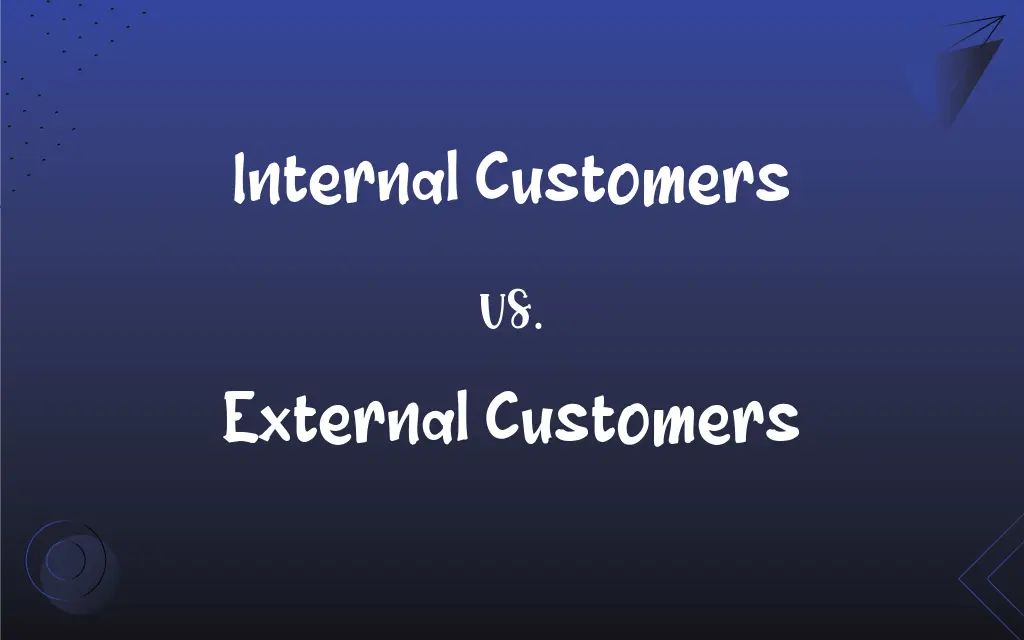Internal Customers vs. External Customers: What's the Difference?
Edited by Aimie Carlson || By Harlon Moss || Updated on June 5, 2024
Internal customers are employees or units serving each other within an organization. External customers are outside individuals or entities purchasing a company’s products or services.

Key Differences
Internal customers refer to individuals or departments within an organization who receive services or products from their colleagues or departments. The term advocates a customer-centric approach towards co-workers to streamline processes and improve service quality. External customers, on the contrary, do not belong to the organization and typically engage in a traditional buyer-seller relationship with it.
The concept of internal customers arises from the belief that treating colleagues as customers can promote a positive work environment. This encompasses meeting their needs and ensuring satisfaction to promote efficient operation. External customers demand a similar level of satisfaction and support, but their transactions typically involve the exchange of goods, services, or money with the company.
While internal customers might demand timely, relevant support or services to perform their job effectively, external customers’ needs and expectations might revolve around product quality, price, availability, and the support provided before and after a purchase.
The satisfaction of internal customers indirectly impacts the satisfaction of external customers. If internal customers are satisfied, it tends to cascade to external customers through improved processes, products, or services. Conversely, satisfying external customers usually entails direct interaction, focusing on meeting their specific requirements and resolving their issues.
Ensuring quality service to internal customers can streamline organizational workflows, thereby enhancing product or service delivery to external customers. On the other hand, directly satisfying external customers is pivotal for generating revenue and sustaining business operations.
ADVERTISEMENT
Comparison Chart
Definition
Employees serving each other within a company
Individuals or entities outside a company purchasing its products or services
Transactional Nature
Often non-monetary, based on services or support
Generally involves monetary transactions for goods or services
Relationship Duration
Ongoing, as long as employment persists
Can be one-time or recurring, depending on customer loyalty
Satisfaction Impact
Impacts organizational workflow and efficiency
Directly impacts revenue and market reputation
Feedback Utilization
Used to improve internal processes and teamwork
Utilized to enhance products, services, and customer support
ADVERTISEMENT
Internal Customers and External Customers Definitions
Internal Customers
Internal customers are individuals within an organization utilizing its services or products.
The marketing team, as internal customers, relies on the IT department for system support.
External Customers
They are direct contributors to a company’s revenue through purchases.
The couple, as external customers, bought a premium membership for the fitness center.
Internal Customers
They are departments that depend on the support of their coworkers or other departments.
The manufacturing unit, as internal customers, needs materials from the procurement department.
External Customers
External customers interact with a company’s products, services, and support.
The gamer, as external customers, reached out for technical support for the newly launched game.
Internal Customers
Internal customers are recipients of products, services, or information from within their organization.
The HR department, as internal customers, uses data provided by the finance team.
External Customers
External customers actively engage in transactions with a business entity.
Parents, as external customers, enrolled their children in the private school.
Internal Customers
They represent an ongoing, interdependent relationship within a company.
Research and development, as internal customers, seeks insights from the sales team.
External Customers
They refer to individuals or organizations not belonging to the vendor's company.
The tourists, as external customers, booked ten rooms for their stay.
Internal Customers
Internal customers are stakeholders who directly influence a company’s operational efficiency.
Operations, as internal customers, require regular updates from the logistics team.
External Customers
External customers are entities purchasing or intending to purchase a company’s offerings.
The retailer, as external customers, ordered 500 units of the new product.
FAQs
Why are internal customers important?
Internal customers are vital because efficient and positive internal service contributes to improved external service and overall organizational success.
Why are external customers important?
External customers drive revenue and can impact a company's reputation through feedback and word of mouth.
What is an external customer?
An external customer is an individual or entity outside of the company that purchases the company’s products or services.
What is an internal customer?
An internal customer is an individual or department within a company that receives goods or services from another individual or department within the same company.
How do external customers interact with a business?
External customers can interact through various channels, such as in-store, online, via customer service, and through social media.
Can external customers impact product development?
Yes, feedback and demands from external customers can influence a company’s product development and offerings.
How can a company support its internal customers?
By promoting effective communication, providing necessary training, and ensuring resources are available for them to perform their tasks efficiently.
What is an example of an external customer?
A shopper who purchases a product from a retail store is an external customer of that store.
How can companies satisfy external customers?
Companies can satisfy external customers by offering quality products/services, excellent customer service, and addressing feedback/complaints adequately.
What is an example of an internal customer?
If the HR department provides training to the sales team, the sales team is the internal customer of the HR department.
Are all external customers consumers?
Not necessarily. External customers can be consumers, businesses, or other entities that purchase or use a company’s products or services.
How to communicate effectively with external customers?
Through clear, respectful, and timely communication across various channels, considering their preferences and needs.
Is the concept of internal customers only applicable to large businesses?
No, businesses of all sizes can have internal customers as long as there are interactions between different individuals or departments.
Are internal customers paid for their role?
No, internal customers are employees and are paid a salary for their overall role, not specifically for being internal customers.
Can an employee be both an internal customer and supplier?
Yes, employees can be both, depending on workflow and organizational structure.
How to identify internal customers?
Internal customers can be identified by determining which individuals or departments rely on others within the company to fulfill their responsibilities.
Can a department be an internal customer?
Yes, entire departments can be internal customers if they receive services from other departments.
Can an individual be both an internal and external customer?
Typically, no. However, if an employee purchases from their company, they act as an external customer in that context.
How do internal customers affect a business?
Positive internal customer relations can enhance productivity and morale, impacting external customer service positively.
Do external customers always purchase products?
No, external customers might also engage with services, and sometimes they might interact with the company without making a purchase.
About Author
Written by
Harlon MossHarlon is a seasoned quality moderator and accomplished content writer for Difference Wiki. An alumnus of the prestigious University of California, he earned his degree in Computer Science. Leveraging his academic background, Harlon brings a meticulous and informed perspective to his work, ensuring content accuracy and excellence.
Edited by
Aimie CarlsonAimie Carlson, holding a master's degree in English literature, is a fervent English language enthusiast. She lends her writing talents to Difference Wiki, a prominent website that specializes in comparisons, offering readers insightful analyses that both captivate and inform.































































